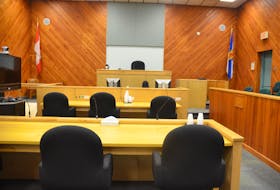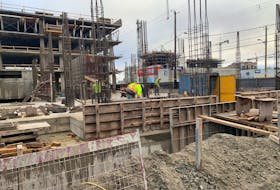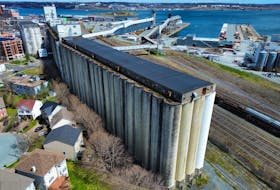"It is good news that critical bear, moose and fisher habitat is safe at least for a while," says FRS chairperson Tom Miller. “But it is ironic, even mindboggling, that habitat next to and intimately connected with the new reserve, despite having been already heavily impacted by past industrial activities, is now slated to be once again subjected to status quo forestry under the Crown license, with the blessing of Minister (Zach) Churchill and DNR."
In December, the Department of Environment designated 50 acres of land near Scotsburn as the MacKay Brook Nature Reserve.
Nature reserves are primarily used for research and education.
Any activities that can cause damage or disturbance to natural features are prohibited, including forestry, mining, road-building, motorized vehicle use, hunting and camping.
Low-impact activities such as birding, canoeing, hiking, and nature photography are generally permitted.
The property contains old hemlock, spruce and hardwood forest, and according to the Department of Environment: “the site offers opportunities for nature appreciation and education in association with adjacent conservation lands recently acquired by Friends of Redtail Society.”
But FRS says another nearby piece of land, owned by the province, is under licence to Port Hawkesbury Paper and is slated to be clear-cut this spring.
FRS is calling on Churchill to reject the cutting plan proposed by PHP, and instead to work with FRS toward implementing the MacKay Brook Community Forest Project Proposal, which the group submitted to DNR in December 2013.
FRS has been trying for almost three years to prevent impending industrial activity on these previously clear-cut, now regenerating Crown lands, by proposing a community forest project that would provide small-scale, long-term opportunities while being sure to also incorporate the other values identified in DNR’s forestry strategy, including healthy ecosystems, recreation, and education.
But, according to the provincial government, the unsolicited proposal that FRS sent to the Department of Natural Resources in December 2013 doesn’t meet its requirements and FRS was asked to try to work with PHP instead.
Carla Grant, director of communications for DNR, says the Crown land that was of interest to the Friends of Redtail Society is needed to meet fibre requirements under Port Hawkesbury Paper’s licence.
“The company offered to work with the group to modify its harvesting plan to address community values.”
FRS member Billy MacDonald says the group has met with PHP several times, but no solutions have been found.
“They asked us to work with PHP, but PHP has presented a forest plan we’re not in agreement with.”
MacDonald says clear-cutting will have negative impacts on the flora and fauna in the area, and damage the FRS lands.
He explains that a flash flood occurred several years ago, washing out bridges in areas below Crown lands where all of the trees had been removed.
“It was a result of the clear cutting. It would never have happened before – the roots of the trees would have held the water.”
FRS, a non-profit organization, fundraised $250,000 to acquire 313 acres of land in December 2010 in order to prevent it from being clear-cut.
The group’s mandate is to educate the public about the importance of the environment, conduct research, and to preserve and protect forest land.
“This area has already been heavily cut and heavily used,” says MacDonald. “Crown land is still being cut when it should be given a rest for future generations. The trees in here should be valued for more than industrial use.”
MacDonald says FRS isn’t against harvesting wood from land, but says this should be done in a responsible way with consideration for wildlife such as fishers, coyotes, snowshoe hares and bobcats that live in the area.
“An overwhelming number of citizens have demanded a move away from the status quo at DNR, but it is clear to us industrial values continue to trump all other values in Nova Scotia woodlands,” Miller says.
The Sheltering Forest project, undertaken by FRS on its lands, aims at preservation, and showing responsible human use of the forest.
The group envisions a demonstration woodlot to remove logs for sale or other uses, and at the same time, focusing on a high level of protection of habitat. FRS also hopes to convince other landowners that it’s possible to take from the forest while preserving it.
On Twitter: @NGNewsCarol
"It is good news that critical bear, moose and fisher habitat is safe at least for a while," says FRS chairperson Tom Miller. “But it is ironic, even mindboggling, that habitat next to and intimately connected with the new reserve, despite having been already heavily impacted by past industrial activities, is now slated to be once again subjected to status quo forestry under the Crown license, with the blessing of Minister (Zach) Churchill and DNR."
In December, the Department of Environment designated 50 acres of land near Scotsburn as the MacKay Brook Nature Reserve.
Nature reserves are primarily used for research and education.
Any activities that can cause damage or disturbance to natural features are prohibited, including forestry, mining, road-building, motorized vehicle use, hunting and camping.
Low-impact activities such as birding, canoeing, hiking, and nature photography are generally permitted.
The property contains old hemlock, spruce and hardwood forest, and according to the Department of Environment: “the site offers opportunities for nature appreciation and education in association with adjacent conservation lands recently acquired by Friends of Redtail Society.”
But FRS says another nearby piece of land, owned by the province, is under licence to Port Hawkesbury Paper and is slated to be clear-cut this spring.
FRS is calling on Churchill to reject the cutting plan proposed by PHP, and instead to work with FRS toward implementing the MacKay Brook Community Forest Project Proposal, which the group submitted to DNR in December 2013.
FRS has been trying for almost three years to prevent impending industrial activity on these previously clear-cut, now regenerating Crown lands, by proposing a community forest project that would provide small-scale, long-term opportunities while being sure to also incorporate the other values identified in DNR’s forestry strategy, including healthy ecosystems, recreation, and education.
But, according to the provincial government, the unsolicited proposal that FRS sent to the Department of Natural Resources in December 2013 doesn’t meet its requirements and FRS was asked to try to work with PHP instead.
Carla Grant, director of communications for DNR, says the Crown land that was of interest to the Friends of Redtail Society is needed to meet fibre requirements under Port Hawkesbury Paper’s licence.
“The company offered to work with the group to modify its harvesting plan to address community values.”
FRS member Billy MacDonald says the group has met with PHP several times, but no solutions have been found.
“They asked us to work with PHP, but PHP has presented a forest plan we’re not in agreement with.”
MacDonald says clear-cutting will have negative impacts on the flora and fauna in the area, and damage the FRS lands.
He explains that a flash flood occurred several years ago, washing out bridges in areas below Crown lands where all of the trees had been removed.
“It was a result of the clear cutting. It would never have happened before – the roots of the trees would have held the water.”
FRS, a non-profit organization, fundraised $250,000 to acquire 313 acres of land in December 2010 in order to prevent it from being clear-cut.
The group’s mandate is to educate the public about the importance of the environment, conduct research, and to preserve and protect forest land.
“This area has already been heavily cut and heavily used,” says MacDonald. “Crown land is still being cut when it should be given a rest for future generations. The trees in here should be valued for more than industrial use.”
MacDonald says FRS isn’t against harvesting wood from land, but says this should be done in a responsible way with consideration for wildlife such as fishers, coyotes, snowshoe hares and bobcats that live in the area.
“An overwhelming number of citizens have demanded a move away from the status quo at DNR, but it is clear to us industrial values continue to trump all other values in Nova Scotia woodlands,” Miller says.
The Sheltering Forest project, undertaken by FRS on its lands, aims at preservation, and showing responsible human use of the forest.
The group envisions a demonstration woodlot to remove logs for sale or other uses, and at the same time, focusing on a high level of protection of habitat. FRS also hopes to convince other landowners that it’s possible to take from the forest while preserving it.
On Twitter: @NGNewsCarol








